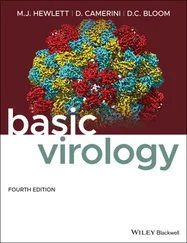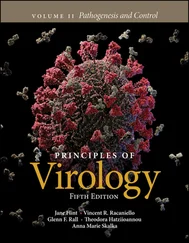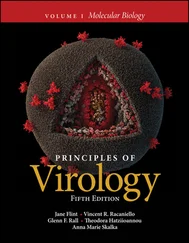Jane Flint - Principles of Virology
Здесь есть возможность читать онлайн «Jane Flint - Principles of Virology» — ознакомительный отрывок электронной книги совершенно бесплатно, а после прочтения отрывка купить полную версию. В некоторых случаях можно слушать аудио, скачать через торрент в формате fb2 и присутствует краткое содержание. Жанр: unrecognised, на английском языке. Описание произведения, (предисловие) а так же отзывы посетителей доступны на портале библиотеки ЛибКат.
- Название:Principles of Virology
- Автор:
- Жанр:
- Год:неизвестен
- ISBN:нет данных
- Рейтинг книги:3 / 5. Голосов: 1
-
Избранное:Добавить в избранное
- Отзывы:
-
Ваша оценка:
- 60
- 1
- 2
- 3
- 4
- 5
Principles of Virology: краткое содержание, описание и аннотация
Предлагаем к чтению аннотацию, описание, краткое содержание или предисловие (зависит от того, что написал сам автор книги «Principles of Virology»). Если вы не нашли необходимую информацию о книге — напишите в комментариях, мы постараемся отыскать её.
Volume I: Molecular Biology
Volume II: Pathogenesis and Control
Principles of Virology, Fifth Edition
Principles of Virology — читать онлайн ознакомительный отрывок
Ниже представлен текст книги, разбитый по страницам. Система сохранения места последней прочитанной страницы, позволяет с удобством читать онлайн бесплатно книгу «Principles of Virology», без необходимости каждый раз заново искать на чём Вы остановились. Поставьте закладку, и сможете в любой момент перейти на страницу, на которой закончили чтение.
Интервал:
Закладка:
From the earliest times, poisonous air (miasma) was generally invoked to account for epidemicsof contagious diseases, and there was little recognition of the differences among causative agents. The association of particular microorganisms, initially bacteria, with specific diseases can be attributed to the ideas of the German physician Robert Koch. He developed and applied a set of criteria for identification of the agent responsible for a specific disease (a pathogen), articulated in an 1890 presentation in Berlin. These criteria, Koch’s postulates, can be summarized as follows.
BOX 1.3
DISCUSSION
Origin of vaccinia virus
Over the years, many hypotheses have been advanced to explain the curious origin of vaccinia virus. However, recent investigations into this mystery by collaborators in the United States, Germany, and Brazil indicate that horsepox, not cowpox, was the likely precursor of vaccine strains of vaccinia virus.
The proverbial smoking gun was an original wooden and glass container that held capillaries with the smallpox vaccine produced in 1902 by H.K. Mulford in Philadelphia (a company that merged with Sharpe and Dohme in 1929). Sequence analysis of the DNA showed that the core genome of the virus in that vial had the highest degree of similarity (99.7%) to horsepox virus. A review of the historical record shows that during the 19th century, pustular material derived from both cowpox and horsepox lesions was used to immunize against smallpox. The latter technique was called equination. Although the disease is now rare in horses and was never reported in the Americas, it was prevalent in Europe, where most vaccine samples were obtained at the time.
Most smallpox vaccines used in the United States, Brazil, and many European countries were produced in the United States from calves inoculated with material collected in 1866 from spontaneous cases of cowpox in France. Genetic analysis of existing samples of these early vaccines indicates that they contained a virus more similar to horsepox and vaccinia viruses than to cowpox virus. While naturally occurring vaccinia viruses are found today only in India (in buffalos) and Brazil (in cows), they can infect horses and people, producing pustular lesions similar to those caused by horsepox and cowpox viruses. One hypothesis is that the ancestor of the current vaccine strain was a naturally occurring vaccinia virus present in the widely distributed French preparation. Alternatively, the vaccine strain may have evolved from horsepox virus during animal passage.
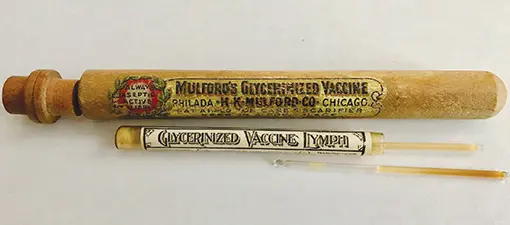
The original wooden (top) and glass (bottom) containers that held capillaries containing the Mulford 1902 smallpox vaccine.Photo kindly provided by Dr. Jose Esparza, Institute of Human Virology, University of Maryland School of Medicine, Baltimore. ©Merck Sharp & Dohme Corp., Merck & Co., Inc.
It is important to consider that development of the smallpox vaccine took place more than a century before modern concepts of virology were established. One can think of other scenarios to explain why the vaccine strain of vaccinia virus is closely related to horsepox and not cowpox, as originally supposed.
The milkmaid with lesions that were the source of Jenner’s original inoculum in 1796 was infected with horsepox, not cowpox. Horsepox can be transmitted to cows, and both animals are common on farms.
Cows from which pustular material was obtained for vaccination were most often infected with horsepox, transmitted by their handlers or by rodents.
The student is invited to conjure up other plausible explanations.
Damaso CR. 2018. Revisiting Jenner’s mysteries, the role of the Beaugency lymph in the evolutionary path of ancient smallpox vaccines. Lancet Infect Dis 18:e55–e63.
Esparza J, Schrick L, Damaso CR, Nitsche A. 2017. Equination (inoculation of horsepox): an early alternative to vaccination (inoculation of cowpox) and the potential role of horsepox virus in the origin of the smallpox vaccine. Vaccine 35:7222–7230.
Schrick L, Tausch SH, Dabrowski PW, Damaso CR, Esparza J, Nitsche A. 2017. An early American smallpox vaccine based on horsepox. N Engl J Med 377:1491–1492.
TWIV 478: A pox on your horse. http://www.microbe.tv/twiv/twiv-478/.
The organism must be regularly associated with the disease and its characteristic lesions.
The organism must be isolated from the diseased host and grown in culture.
The disease must be reproduced when a pure culture of the organism is introduced into a healthy, susceptible host.
The same organism must be reisolated from the experimentally infected host.
Modern technology has allowed some of Koch’s principles to be amended by the application of other types of evidence ( Box 1.4). However, by applying his criteria, Koch demonstrated that anthrax, a common disease of cattle, was caused by a specific bacterium (designated Bacillus anthracis ) and that a second, distinct bacterial species caused tuberculosis in humans. Guided by these postulates and the methods for the sterile culture and isolation of pure preparations of bacteria developed by Pasteur, Joseph Lister, and Koch, many pathogenic bacteria (as well as yeasts and fungi) were identified and classified during the last part of the 19th century ( Fig. 1.7). From these beginnings, investigation into the causes of infectious disease was placed on a secure scientific foundation, the first step toward rational treatment and ultimately control. Furthermore, during the last decade of the 19th century, failures of the paradigm that bacterial or fungal agents are responsible for alldiseases led to the identification of a new class of infectious agents—submicroscopic pathogens that came to be called viruses.
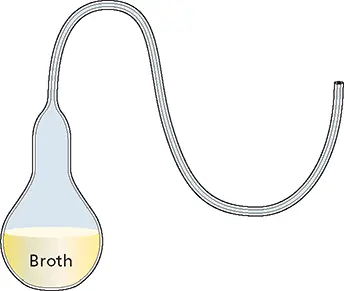
Figure 1.6 Pasteur’s famous swan-neck flasks provided passive exclusion of microbes from the sterilized broth. Although the flask was freely open to the air at the end of the long, curved stem, the broth remained sterile, provided that microbe-bearing dust that collected in the neck of the stem did not reach the liquid.
Discovery of Viruses
The first report of a pathogenic agent smaller than any known bacterium appeared in 1892. The Russian scientist Dimitrii Ivanovsky observed that the causative agent of tobacco mosaic disease was not retained by the unglazed filters used at that time to remove bacteria from extracts and culture medium ( Fig. 1.8A). Six years later in Holland, Martinus Beijerinck independently made the same observation. More importantly, Beijerinck made the conceptual leap that this must be a distinctive agent, because it was so small that it could pass through filters that trapped all known bacteria. However, Beijerinck thought that the agent was an infectious liquid. It was two former students and assistants of Koch, Friedrich Loeffler and Paul Frosch, who in the same year (1898) deduced that such infectious filterable agents comprised small particles: they observed that while the causative agent of foot-and-mouth disease ( Box 1.2) passed through filters that held back bacteria, it could be retained by a finer filter.
Not only were the tobacco mosaic and foot-and-mouth disease pathogens much smaller than any previously recognized microorganism, but also they could only reproduce in their host organisms. For example, extracts of an infected tobacco plant diluted into sterile solution produced no additional infectious agents until introduced into leaves of healthy plants, which subsequently developed tobacco mosaic disease. The serial transmission of infection by diluted extracts established that these diseases were not caused by a bacterial toxin present in the original preparations derived from infected tobacco plants or cattle. The failure of both pathogens to multiply in solutions that readily supported the growth of bacteria, as well as their dependence on host organisms for reproduction, further distinguished these new agents from pathogenic bacteria. Beijerinck termed the submicroscopic agent responsible for tobacco mosaic disease contagium vivum fluidum to emphasize its infectious nature and distinctive reproductive and physical properties. Agents passing through filters that retain bacteria came to be called ultrafilterable viruses, appropriating the term virus from the Latin for “poison.” This term was simplified eventually to “virus.”
Читать дальшеИнтервал:
Закладка:
Похожие книги на «Principles of Virology»
Представляем Вашему вниманию похожие книги на «Principles of Virology» списком для выбора. Мы отобрали схожую по названию и смыслу литературу в надежде предоставить читателям больше вариантов отыскать новые, интересные, ещё непрочитанные произведения.
Обсуждение, отзывы о книге «Principles of Virology» и просто собственные мнения читателей. Оставьте ваши комментарии, напишите, что Вы думаете о произведении, его смысле или главных героях. Укажите что конкретно понравилось, а что нет, и почему Вы так считаете.





